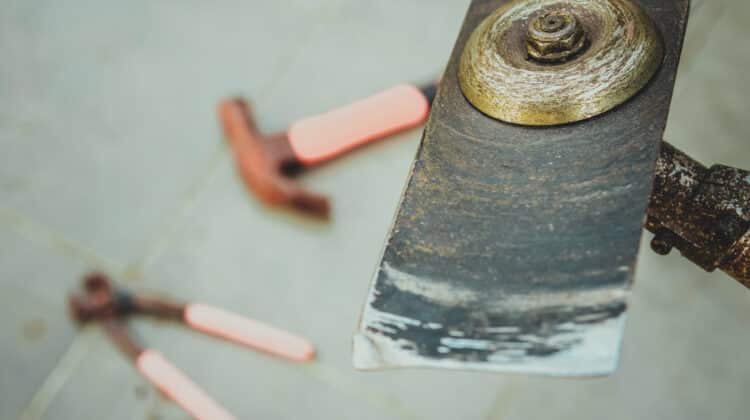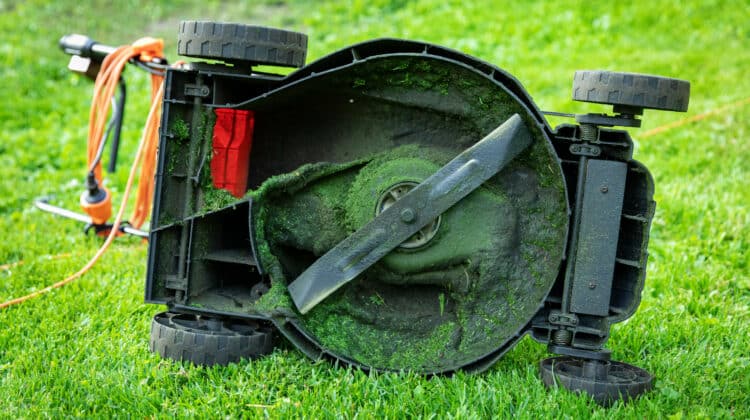Are you curious to find out how to balance lawn mower blades?
A lawnmower is a piece of necessary gardening equipment that every homeowner with a lawn should own. It is a way to beautify and add aesthetic value to a home. And to make this possible, you need to keep your lawnmower in tiptop shape.
However, if you notice it is vibrating more than necessary and not cutting grass as it should be, there is a significant problem you need to deal with. The issue might be unbalanced lawnmower blades, which you need to balance back to make them cut grass properly again.
Table of Contents
What are the steps in balancing lawnmower blades?
Why the mower blades are unbalanced
Learning how to balance lawnmower blades is essential if achieving a perfectly trimmed yard. If your lawn is shabby, patch, uneven, and turns to brown the next day after mowing, the problem might be unbalanced rotor blades.
During a mowing season, your lawnmower will be exposed to debris other than grass, like rocks, twigs, and household accessories mistakenly left on the yard. As a result, your lawn mower blades will become blunt, dented, and unbalanced. If you continue using them without balancing them back, you will end up damaging your lawn.
Ideally, you have to balance your mower blades at least twice during a mowing season. Balancing them entails evenly distributing them from one side to another.
A lawnmower blade should be inclined at the middle, enabling the two sides to have even size and weight.
Yet the blades will become unbalanced when they are not properly sharpened and if one side is ground off more than the other. It will make one side heavier than the other, making it unbalanced
Since it is unbalanced, it will result in more issues wherein the internal structural bolts will either snap or loosen. It will create stress on the spindle, the blade shift, and more seriously, the engine. It will result to the whole mower vibrate more than usual when mowing, and will take longer for the grass-cutting task to finish.
Tools and materials you need to balance your mower blades
- Safety goggles
- Ear muffs
- Steel brush
- Wrench
- Bench grinder or any sharpening tool
- Blade balancer
The significance of balancing your mower blades is not only for getting a perfectly trimmed lawn, but for the damage, it can incur to your mower. If you want it to be with you for a long time to cut your lawn, you will need to keep the blades properly balanced.
Here are the steps in balancing your lawnmower blades:
- Activating the mower’s parking mode – Before undergoing the balancing process, bring the lawnmower to an area with a flat surface so you can work properly. To enable parking mode, press the parking brake.
- Disconnecting the battery cable in your mower – You also have to practice safety, so you need to disconnect the power cable to avoid being electrocuted.
- Unplugging the mower’s spark plug – At this stage, the ignition is off, and no electricity is flowing in the engine. It is because the battery cable has been disconnected.
Another safety precaution is disconnecting the sparkplug wire, so lift the hood and look for it to detach it. Then tape it back with electrical tape so it would not fall back and touch the plug.
You can also inspect the sparkplug if it needs cleaning or replacement.
- Tilting the lawnmower to its side – You will need the carburetor and air filter to be upwards, so tilt the lawnmower on its side. It will keep the oil and gasoline from pouring into the air filter.
- Removing the mower blade – To remove the rotor blade, wedge a two-by-four between the mower deck and the blade. Use a wrench to loosen the nut and turn it counterclockwise to take out the bolt and blade.
- Getting rid of the dust and debris in the mower blade – Remove any debris on the blade with a steel brush. Then carefully examine it if it needs replacement.
- Sharpening the blade – A properly balanced blade means it is sharpened evenly. With a grinder or file, look for the original angle of the blade edge and sharpen it. Make sure you maintain the original angle and sharpen it in only one direction. Ensure you are removing the same amount of steel from each cutting edge.
- Marking the new blade – Many homeowners commit this error by reattaching the blade upside down after sharpening, which cannot cut grass. To know the right position of the blade once reattaching it, put a marking on it like spraying spray paint.
- Checking the balance of the blade – To check for balance, put the blade on a nail, and if one area dips, file or grinds it off until the cutting edges are even.
- Reinstalling the blade – After making sure the blade is completely balanced, reattach it back by screwing it in with a bolt or nut.
Put a two-by-four in reverse position to tighten the breaker bar by bearing down on it. And also, be sure to correctly tighten the bolt since a loose blade can disrupt the timing of the engine, thus making it difficult to start.
- Testing the blade – The blade balancing procedure is done, so test it out and drive the mower to a grassy area.
If you do not feel any vibration anymore and the grass cutting is perfectly cut, and even, the procedure worked. If not, get professional help since operating on an unbalanced lawnmower may cause accidents in the future.
How many times should I sharpen my lawnmower blade?
A blunt blade will not only be bad for the lawnmower itself but worse for the grass. Since it will get ragged, torn and promote fungi growth and other diseases.
When this happens, there is no reason to panic and it means you only need to sharpen the blades. To attain perfectly-trimmed and healthy grass, you should sharpen the blades at least once or twice a month, depending on how you use it.
To determine if the blade needs sharpening, examine the newly-mowed grass for a few minutes. It looks ragged and torn, it needs sharpening.
How to balance the lawnmower blade after sharpening it
If you are the one sharpening, there is a big chance you did not do it evenly, which causes one side to be heavier than the other. It will result in vibrations, faster wear and tear, and loosening of nuts and bolts.
After sharpening the blades, you can do these steps to check for its balance before reattaching it:
- Attach the mower blade on a nail head – Drive a large enough nail into a piece of wooden plank on the wall of your garage or shed with a hammer. Take the blade and position it on the base of the nail (there is a hole on the blade that will fit the nail head).
- Rotating the mower blade – Slowly rotate the blade to the right, and if it remains in position, it is balanced. However, if the blade rotates back to where it started, it is unbalanced, and the portion of the blade at the bottom is heavy.
- Filing or grinding the mower blade – After establishing the part of the blade that requires sharpening, take it to your workspace to sharpen it. Take note of the area that needs to be sharpened and begin the process as mentioned in the previous steps above.
- Rechecking the balance of the blade – Once done, wipe the blade clean and take it again to the nail head as previously done before. Do the aforementioned step again to check for the balance.
- Repeat the process if the blade is still unbalanced – If you determined that the blade is balanced, attach it back to your mower. But if it still is unbalanced, do the procedure again.
After redoing the process and attaining a well-balanced sharpness of your lawnmower blade, install it back to the mower. You can now mow perfectly-trimmed grass during the whole season.
Is learning how to balance lawn mower blades worth it?
For a responsible homeowner who cares for home beautification, learning the proper steps in balancing your lawnmower blades is practicable information.
Sustainably managing a well-manicured lawn is truly magnificent talent and will be the envy of the neighborhood.





